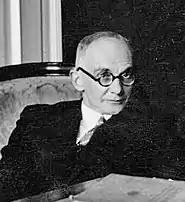Stefan Mazurkiewicz | |
|---|---|
 Stefan Mazurkiewicz 1935 | |
| Born | 25 September 1888 |
| Died | 19 June 1945 (aged 56) |
| Nationality | Polish |
| Alma mater | University of Lwów |
| Known for | Hahn–Mazurkiewicz theorem |
| Scientific career | |
| Fields | Mathematics |
| Institutions | University of Warsaw |
| Doctoral advisor | Wacław Sierpiński |
Stefan Mazurkiewicz (25 September 1888 – 19 June 1945) was a Polish mathematician who worked in mathematical analysis, topology, and probability. He was a student of Wacław Sierpiński and a member of the Polish Academy of Learning (PAU). His students included Karol Borsuk, Bronisław Knaster, Kazimierz Kuratowski, Stanisław Saks, and Antoni Zygmund. For a time Mazurkiewicz was a professor at the University of Paris; however, he spent most of his career as a professor at the University of Warsaw.
| Methods and technology |
|---|
| Locations |
| Personnel |
|
Chief
Gwido Langer German Section cryptologists Wiktor Michałowski
Chief of Russian Section
Jan Graliński Russian Section cryptologist
Piotr Smoleński |
The Hahn–Mazurkiewicz theorem, a basic result on curves prompted by the phenomenon of space-filling curves, is named for Mazurkiewicz and Hans Hahn. His 1935 paper Sur l'existence des continus indécomposables is generally considered the most elegant piece of work in point-set topology.
During the Polish–Soviet War (1919–21), Mazurkiewicz as early as 1919 broke the most common Russian cipher for the Polish General Staff's cryptological agency. Thanks to this, orders issued by Soviet commander Mikhail Tukhachevsky's staff were known to Polish Army leaders. This contributed substantially, perhaps decisively, to Polish victory at the critical Battle of Warsaw and possibly to Poland's survival as an independent country.
See also
External links
- Stefan Mazurkiewicz at the Mathematics Genealogy Project
- O'Connor, John J.; Robertson, Edmund F., "Stefan Mazurkiewicz", MacTutor History of Mathematics Archive, University of St Andrews